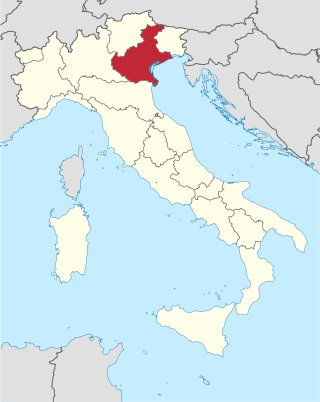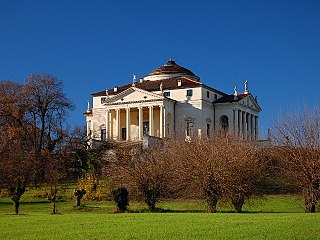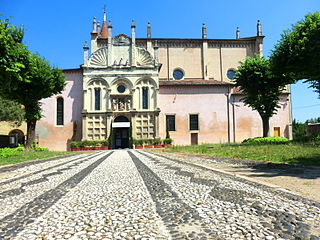Origins
From Roman times, the original name of the nearby village that eventually became Villaverla was "Roveredum." The center of that first village was likely located in the area where April 25 Road and Roare Road intersect, suggested by archaeological finds at an old brickyard nearby (Roman coins and traces of arched brick walls of Roman origin.)
Around 1004 AD, Giovanni Verla (Giovanni of Werla) and perhaps other of his family members, came from the area of Werlaburgdorf Germany with Holy Roman Emperor Henry II in a military campaign to put down a revolt by Arduin, Marquis of Ivrea. Giovanni and his relatives (originally referred to as the Werlas, later as Verlas or Verlatti, and today Verlato) were subsequently granted land by the Emperor in the towns of Thiene, Zane and what was then Roveredum. [3]
The name "Villaverla" literally means "Village of the Verla." This was a reflection of both the influence that the Verlato family had at the time and the manner in which the family was referred to (i.e. Verla or Verlatti) during the time the modern town's name was being adopted. The name Villaverla began to be adopted around the end of the 13th century and was well established by around 1663 when Pagliarino wrote his history of the area.
A villa/palazzo for the Verlato family (Today known as the "Villa Verlato") was completed in Villaverla around 1574, and was designed by renowned architect Vicenzo Scamozzi [4] This most likely influenced both the future physical development of the town as well as the adoption of the name Villaverla in the place of Roveredum. The Villa Verlato has survived the centuries and is located today in the center of the town at 9 Piazza del Popolo.

Veneto or the Venetia is one of the 20 regions of Italy, located in the north-east of the country. It is the fourth most populous region in Italy, with a population of about five million. Venice is the region's capital and the largest city.

Padua is a city and commune in Veneto, northern Italy, and the capital of the eponymous province of Padua. The city lies on the banks of the river Bacchiglione, 40 kilometres west of Venice and 29 km southeast of Vicenza, and has a population of 214,000. It is also the economic and communications hub of the area. Padua is sometimes included, with Venice and Treviso, in the Padua-Treviso-Venice Metropolitan Area (PATREVE) which has a population of around 2,600,000.

Vicenza is a city in northeastern Italy. It is in the Veneto region, at the northern base of the Monte Berico, where it straddles the River Bacchiglione. Vicenza is approximately 60 kilometres (37 mi) west of Venice and 200 kilometres (120 mi) east of Milan.

Cisterna di Latina is a town and comune in the province of Latina in Lazio, of central Italy. It was the scene of the Battle of Cisterna in January 1944.

Vincenzo Scamozzi was an Italian architect and a writer on architecture, active mainly in Vicenza and Republic of Venice area in the second half of the 16th century. He was perhaps the most important figure there between Andrea Palladio, whose unfinished projects he inherited at Palladio's death in 1580, and Baldassarre Longhena, Scamozzi's only pupil.

Andrea Palladio was an Italian Renaissance architect active in the Venetian Republic. Palladio, influenced by Roman and Greek architecture, primarily Vitruvius, is widely considered to be one of the most influential individuals in the history of architecture. While he designed churches and palaces, he was best known for country houses and villas. His teachings, summarized in the architectural treatise, The Four Books of Architecture, gained him wide recognition.

The Teatro Olimpico is a theatre in Vicenza, northern Italy, constructed in 1580–1585. It was the final design by the Italian Renaissance architect Andrea Palladio and was not completed until after his death. The trompe-l'œil onstage scenery, designed by Vincenzo Scamozzi to give the appearance of long streets receding to a distant horizon, was installed in 1585 for the first performance held in the theatre, and is the oldest surviving stage set still in existence. The full Roman-style scaenae frons back screen across the stage is made from wood and stucco imitating marble. It was the home of the Accademia Olimpica, which was founded there in 1555.

Villa La Rotonda is a Renaissance villa just outside Vicenza in Northern Italy designed by Italian Renaissance architect Andrea Palladio, and begun in 1567, though not completed until the 1590s. The villa's official name is Villa Almerico Capra Valmarana, but it is also known as "La Rotonda", "Villa Rotonda", "Villa Capra", and "Villa Almerico Capra". The name Capra derives from the Capra brothers, who completed the building after it was ceded to them in 1592. Along with other works by Palladio, the building is conserved as part of the World Heritage Site "City of Vicenza and the Palladian Villas of the Veneto".
Caldogno is a town and comune near Vicenza in Italy. It has a population of 11,337 inhabitants.
Valdagno is a town and comune in the province of Vicenza, north-eastern Italy. The town was the birthplace of the textile manufacturing company Marzotto, and home to the Italian hotel chain "Jolly Hotels".

Lonigo is a town and comune in the province of Vicenza, Veneto, northern Italy, its population counts around 16,400 inhabitants.

Villa Chiericati is a villa at Vancimuglio in the Veneto, northern Italy. It was designed for Giovanni Chiericati by the architect Andrea Palladio in the early 1550s.

Mussolente is a town in the province of Vicenza, Veneto, northern Italy. It is north of SS248 state road.

Villa Pojana or Poiana, is a patrician villa in Pojana Maggiore, a town of the Province of Vicenza in the Veneto region of Italy. It was designed by the Italian Renaissance architect Andrea Palladio. It is conserved as part of the UNESCO World Heritage Site "City of Vicenza and the Palladian Villas of the Veneto".

The Villa Forni Cerato is a 16th-century villa in Montecchio Precalcino, Province of Vicenza, northern Italy. Its design is attributed to Andrea Palladio and his client is assumed to have been Girolamo Forni, a wealthy wood merchant who supplied building material for a number of the Palladio's projects. The attribution to Palladio is partly based on stylistic grounds, although the building departs from the Palladian norms.

The Villa Gazzotti Grimani (1542) is a Renaissance villa, an early work of architect Andrea Palladio, located in the village of Bertesina, near Vicenza in the Veneto region of northern Italy.

The Palazzo Porto is a palace in Piazza Castello, Vicenza, northern Italy. It is one of two palazzi in the city designed by Andrea Palladio for members of the Porto family. Only two bays of it were ever built, beginning shortly after 1571. Why the patron, Alessandro Porto, did not continue with the project is not known.

Villa Piovene is a Palladian villa built in Lugo di Vicenza, province of Vicenza, northern Italy. The building was commissioned in the 16th century for the aristocratic Venetian Piovene family, their architect believed to have been Andrea Palladio. It is part of the World Heritage Site "City of Vicenza and the Palladian Villas of the Veneto" since 1996.

Palazzo Barbaran da Porto is a palazzo in Vicenza, Italy designed in 1569 and built between 1570 and 1575 by Italian Renaissance architect Andrea Palladio.

Palazzo Civena is a Renaissance palace in Vicenza, Italy, dating to 1540. It was the first palace designed by Andrea Palladio for Giovanni Civena.




















